Stress State Analysis of the Soil Plug of Open-Ended Piles during Impact Driving Using Particle Flow Code (PFC)
Abstract
1. Introduction
2. Methodology
2.1. Laboratory Model Pile Test
2.2. Granular Assembly in PFC Modeling
2.3. Sample Preparation in PFC Modeling
2.4. Simulation of Pile Installation
2.5. Research Program
3. Simulation Results and Discussion
3.1. Validation of Soil–Soil Interaction
3.2. Validation of Soil–Pile Interaction
3.3. Measurements of Soil Plug
3.4. Progressive Internal Stress State of the Soil Plug
3.5. Local Stress State of the Soil Plug
3.6. Effect of Pile Diameter
3.6.1. Influence on Plug Length
3.6.2. Impact on the Internal Stress State of the Soil Plug
4. Conclusions
- Successful simulation of soil plug formation through the DEM was conducted and verified by calibrating both biaxial compression test results and plug length indices from the simulation to the physical test results.
- Plug length indices (e.g., PLR and IFR) started at approximately 1 at the beginning of the penetration and generally decreased with the progression of pile installation. The PLR exhibited a gradual decrease without any fluctuation, ending at 0.5, whereas the IFR showed significant fluctuation, including a sudden increase from 0.006 to 0.5 and a drastic drop from 0.8 to 0.1. Hardening and release in the horizontal stress within the soil plug were accompanied by a sudden drop and increase in the IFR, respectively. It is considered that the IFR better indicates the internal state of the soil plug than the PLR.
- Due to the high degree of spatial variance in the internal horizontal stress during penetration, dividing the soil plug into three equal parts based on length results in each section showing distinctive variations in mechanical behavior. While the top section did not exhibit any stress variation due to penetration, the middle and bottom sections experienced substantial changes in the horizontal stress, surging from the overburden stress to a maximum stress of 349 kPa, corresponding to a coefficient of lateral earth pressure (K) of 3.4. The IFR of 0.1 at this stage also indicated a high degree of plugging state. A phenomenon was also observed where the excessive horizontal stress developed at the bottom section in the former penetration stage was pushed upward to the middle section with a slight alleviation in magnitude during subsequent impact driving.
- The active length, where excessive horizontal stress developed within the soil plug, was measured as 2 Din from the pile tip at specific penetration phases in which the degree of plugging was highly developed. The location of the maximum horizontal stress within the active length was 1 Din from the pile tip.
- The plug length increased with pile diameter, as indicated by larger PLR and IFR values. However, the longer formation of the soil plug did not indicate a trend of the internal stress state since the maximum horizontal stress per each impact driving was not significantly affected by the pile diameter.
- In the results from all parametric models, the earliest plugging effect was observed at a penetration progress of 60~65% of the total penetration, where the maximum horizontal stress developed regardless of the pile diameter.
- The beta index obtained from the known PLR and relationship () was determined to be 0.6, while the one obtained from the direct stress state within the soil plug () was 1.7. It showed that for a given plugging state, there was a possibility of underestimating the inner skin friction of an open-ended pile if it was designed in terms of plug length indices.
- Soil plugs at penetration stages where excessive horizontal stress had developed exhibited a highly passive state, indicated by a high Kin (lateral earth pressure coefficient within the soil plug). The maximum Kin throughout the entire penetration process was observed to be 3.4, whereas Kout (K measured near the outer shaft of the pile) was 1. Beta values determined from K were found to range from 1 to 3.6, surpassing the values of current design codes.
Author Contributions
Funding
Institutional Review Board Statement
Informed Consent Statement
Data Availability Statement
Conflicts of Interest
References
- Viggiani, C.; Mandolini, A.; Russo, G. Piles and Pile Foundations; CRC Press: Boca Raton, FL, USA, 2014. [Google Scholar]
- Meyerhof, G.G. Compaction of sands and bearing capacity of piles. J. Soil Mech. Found. Div. 1959, 85, 1292–1322. [Google Scholar] [CrossRef]
- Randolph, M.; Gourvenec, S. Offshore Geotechnical Engineering; CRC Press: Boca Raton, FL, USA, 2017. [Google Scholar]
- Paikowsky, S.G. A Static Evaluation of Soil Plug Behavior with Application to the Pile Plugging Problem. Doctoral Dissertation, Massachusetts Institute of Technology, Cambridge, MA, USA, February 1989. [Google Scholar]
- Paikowsky, S.G. The mechanism of pile plugging in sand. In Proceedings of the Offshore Technology Conference, Houston, TX, USA, 7–10 May 1990. [Google Scholar]
- Szechy, C.H. Tests with tubular piles. Acta Tech. 1959, 24, 181. [Google Scholar]
- Paik, K.; Salgado, R. Determination of bearing capacity of open-ended piles in sand. J. Geotech. Geoenviron. Eng. 2003, 129, 46–57. [Google Scholar] [CrossRef]
- Paik, K.; Salgado, R. Effect of pile installation method on pipe pile behavior in sands. Geotech. Test. J. 2004, 27, 11391. [Google Scholar] [CrossRef]
- Henke, S.; Grabe, J. Numerical investigation of soil plugging inside open-ended piles with respect to the installation method. Acta Geotech. 2008, 3, 215–223. [Google Scholar] [CrossRef]
- Li, L.; Wu, W.; Liu, H.; Lehane, B. DEM analysis of the plugging effect of open-ended pile during the installation process. Ocean Eng. 2021, 220, 108375. [Google Scholar] [CrossRef]
- Ko, J.; Jeong, S.; Seo, H. Effect of soil condition on the coefficient of lateral earth pressure inside an open-ended pipe pile. Geomech. Eng. 2022, 31, 209–222. [Google Scholar] [CrossRef]
- Brucy, F.; Meunier, J.; Nauroy, J.F. Behavior of pile plug in sandy soils during and after driving. In Proceedings of the Offshore Technology Conference, Houston, TX, USA, 6–9 May 1991. [Google Scholar]
- Lu, J.; Guang, H.; Cui, L.; Liu, J.; Wang, C.; Kumar, S.A. Experimental study on penetration characteristics of an open-ended pile under static and dynamic driving methods. Soil Dyn. Earthq. Eng. 2023, 166, 107770. [Google Scholar] [CrossRef]
- Paikowsky, S.G.; Whitman, R.V. The effects of plugging on pile performance and design. Can. Geotech. J. 1990, 27, 429–440. [Google Scholar] [CrossRef]
- Paik, K.H.; Lee, S.R. Behavior of soil plugs in open-ended model piles driven into sands. Mar. Georesources Geotechnol. 1993, 11, 353–373. [Google Scholar] [CrossRef]
- Jardine, R.; Chow, F.; Overy, R.; Standing, J. ICP Design Methods for Driven Piles in Sands and Clays; Thomas Telford: London, UK, 2005. [Google Scholar]
- Rausche, F.; Webster, S. Behavior of cylinder piles during pile installation. In Proceedings of the Contemporary Issues in Deep Foundations, Denver, CO, USA, 18 February 2007. [Google Scholar]
- Gudavalli, S.R.; Safaqah, O.; Seo, H. Effect of soil plugging on axial capacity of open-ended pipe piles in sands. In Proceedings of the 18th International Conference on Soil Mechanics and Geotechnical Engineering, Paris, France, 2–6 September 2013. [Google Scholar]
- Ko, J.; Jeong, S. Plugging effect of open-ended piles in sandy soil. Can. Geotech. J. 2015, 52, 535–547. [Google Scholar] [CrossRef]
- Randolph, M.F. Potential damage to steel pipe piles during installation. IPA Newsl. 2018, 3, 3–10. [Google Scholar]
- CGS (Canadian Geotechnical Society). Canadian Foundation Engineering Manual; Canadian Geotechnical Society: Toronto, ON, Canada, 2006. [Google Scholar]
- 2GEO/ISO 19901-4; Geotechnical and Foundation Design Considerations: ANSI/API Recommended Practice, 1st ed. API (American Petroleum Institute): Washington, DC, USA, 2011.
- Henke, S.; Bienen, B. Centrifuge tests investigating the influence of pile cross-section on pile driving resistance of open-ended piles. Int. J. Phys. Model. Geotech. 2013, 13, 50–62. [Google Scholar] [CrossRef]
- Kim, Y.; Jeong, S.S. Analysis of dynamically penetrating anchor based on coupled Eulerian-Lagrangian (CEL) method. KSCE J. Civ. Environ. Eng. Res. 2014, 34, 895–906. [Google Scholar] [CrossRef]
- Ko, J.; Jeong, S.; Lee, J.K. Large deformation FE analysis of driven steel pipe piles with soil plugging. Comput. Geotech. 2016, 71, 82–97. [Google Scholar] [CrossRef]
- Daryaei, R.; Bakroon, M.; Aubram, D.; Rackwitz, F. Numerical evaluation of the soil behavior during pipe-pile installation using impact and vibratory driving in sand. Soil Dyn. Earthq. Eng. 2020, 134, 106177. [Google Scholar] [CrossRef]
- Augarde, C.E.; Lee, S.J.; Loukidis, D. Numerical modelling of large deformation problems in geotechnical engineering: A state-of-the-art review. Soils Found. 2021, 61, 1718–1735. [Google Scholar] [CrossRef]
- Qin, W.; Cai, S.; Dai, G.; Wang, D.; Chang, K. Soil resistance during driving of offshore large-diameter open-ended thin-wall pipe piles driven into clay by impact hammers. Comput. Geotech. 2023, 153, 105085. [Google Scholar] [CrossRef]
- Duan, N.; Cheng, Y.P.; Liu, J.W. DEM analysis of pile installation effect: Comparing a bored and a driven pile. Granul. Matter 2018, 20, 36. [Google Scholar] [CrossRef]
- Li, L.; Wu, W.; El Naggar, M.H.; Mei, G.; Liang, R. DEM analysis of the sand plug behavior during the installation process of open-ended pile. Comput. Geotech. 2019, 109, 23–33. [Google Scholar] [CrossRef]
- Liu, J.; Duan, N.; Cui, L.; Zhu, N. DEM investigation of installation responses of jacked open-ended piles. Acta Geotech. 2019, 14, 1805–1819. [Google Scholar] [CrossRef]
- Kim, M.; Li, L.; Seo, H. Effect of a constrictor plate on behavior of a model steel pipe pile driven in dense sand. Ocean Eng. 2023, 267, 113210. [Google Scholar] [CrossRef]
- Huang, A.B.; Ma, M.Y. An analytical study of cone penetration tests in granular material. Can. Geotech. J. 1994, 31, 91–103. [Google Scholar] [CrossRef]
- Lobo-Guerrero, S.; Vallejo, L.E. DEM analysis of crushing around driven piles in granular materials. Geotechnique 2005, 55, 617–623. [Google Scholar] [CrossRef]
- Itasca Consulting Group, Inc. Itasca’s Particle Flow Code Documentation, version 6.0; Itasca Consulting Group: Minneapolis, MN, USA, 2021.
- Lee, J.; Prezzi, M.; Salgado, R. Experimental investigation of the combined load response of model piles driven in sand. Geotech. Test. J. 2011, 34, 653–667. [Google Scholar] [CrossRef]
- El-Sekelly, W.; Tessari, A.; Abdoun, T. Shear wave velocity measurement in the centrifuge using bender elements. Geotech. Test. J. 2014, 37, 689–704. [Google Scholar] [CrossRef]
- Zhang, M.X.; Qiu, C.C.; Javadi, A.A.; Lu, Y.; Zhang, S.L. Discrete-element method simulation of a model test of an embankment reinforced with horizontal–vertical inclusions. Geosynth. Int. 2013, 20, 238–251. [Google Scholar] [CrossRef]
- Esposito, R.G.; Velloso, R.Q.; do Amaral Vargas, E., Jr.; Danziger, B.R. Multi-scale sensitivity analysis of pile installation using DEM. Comput. Part. Mech. 2018, 5, 375–386. [Google Scholar] [CrossRef]
- Salot, C.; Gotteland, P.; Villard, P. Influence of relative density on granular materials behavior: DEM simulations of triaxial tests. Granul. Matter 2009, 11, 221–236. [Google Scholar] [CrossRef]
- Muir Wood, D.; Maeda, K. Changing grading of soil: Effect on critical states. Acta Geotech. 2008, 3, 3–14. [Google Scholar] [CrossRef]
- Yin, Z.; Wang, P. Micro-mechanical analysis of caisson foundation in sand using DEM: Particle shape effect. Appl. Ocean Res. 2021, 111, 102630. [Google Scholar] [CrossRef]
- Wang, P.; Yin, Z.Y.; Zhou, W.H.; Chen, W.B. Micro-mechanical analysis of soil–structure interface behavior under constant normal stiffness condition with DEM. Acta Geotech. 2022, 17, 2711–2733. [Google Scholar] [CrossRef]
- Seo, H.; Kim, M. Soil plug behaviour of open-ended pipe piles during installation. DFI J. 2017, 11, 128–136. [Google Scholar] [CrossRef]
- Jeong, S.; Ko, J.; Won, J.; Lee, K. Bearing capacity analysis of open-ended piles considering the degree of soil plugging. Soils Found. 2015, 55, 1001–1014. [Google Scholar] [CrossRef]
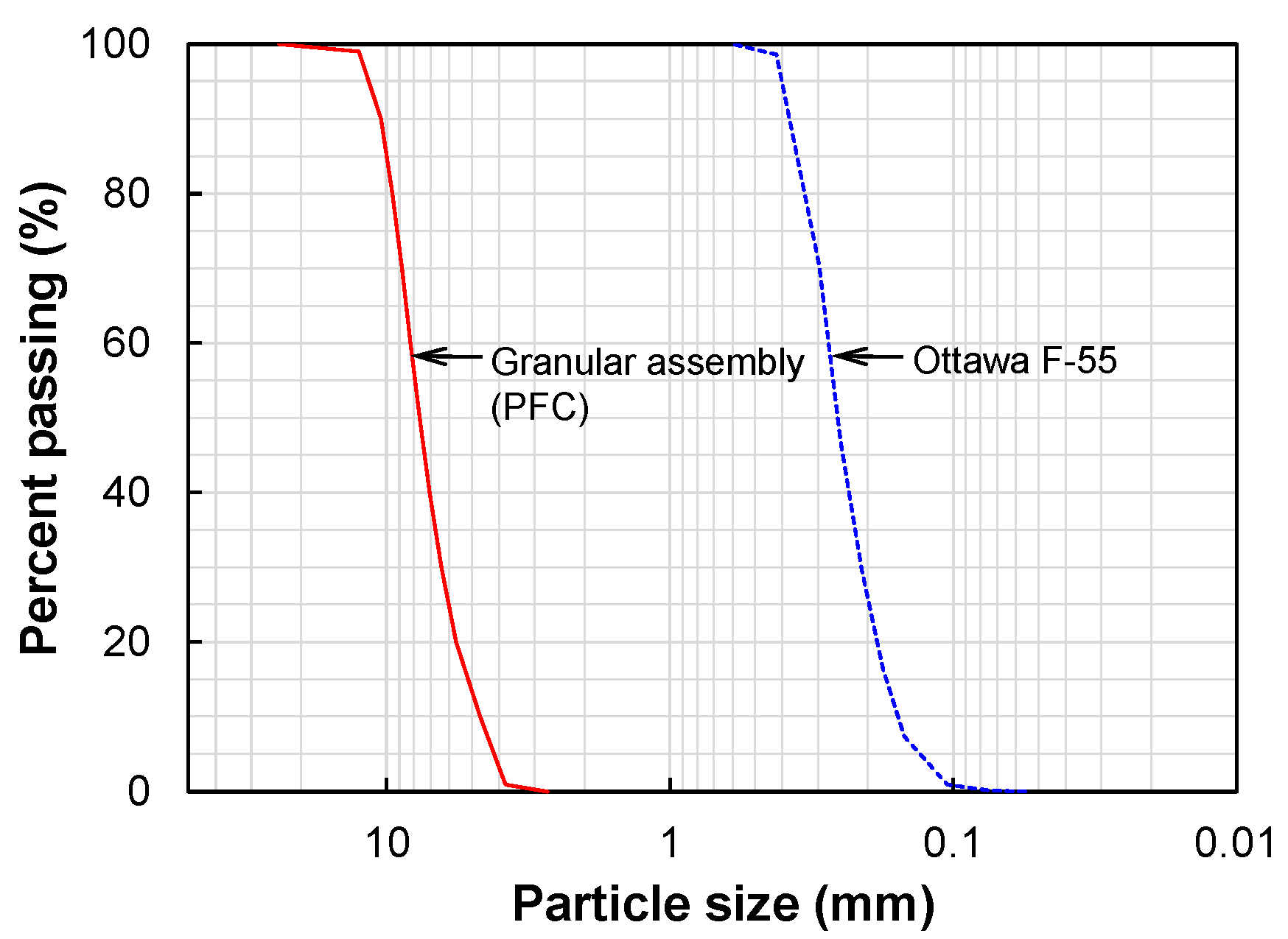

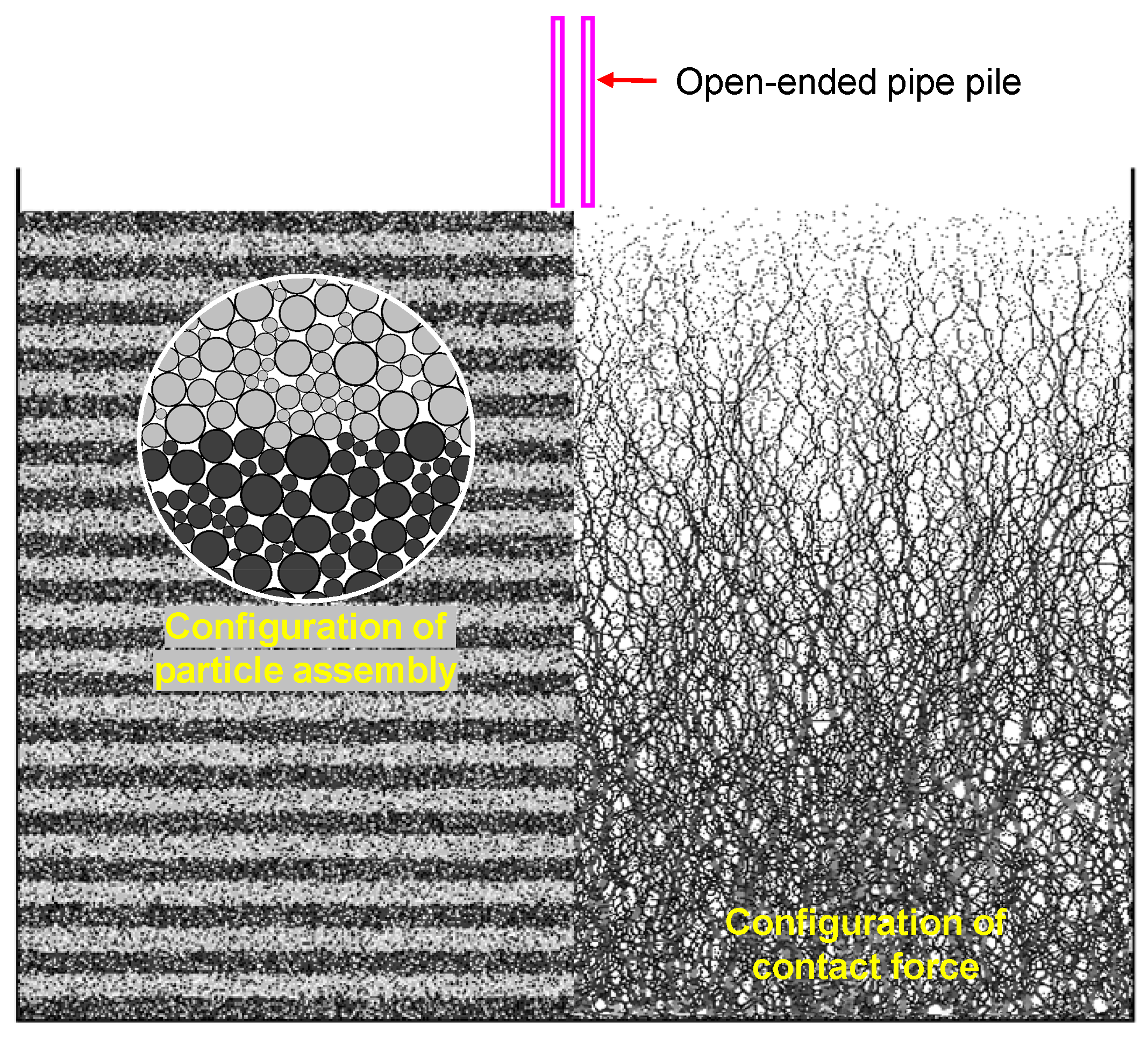
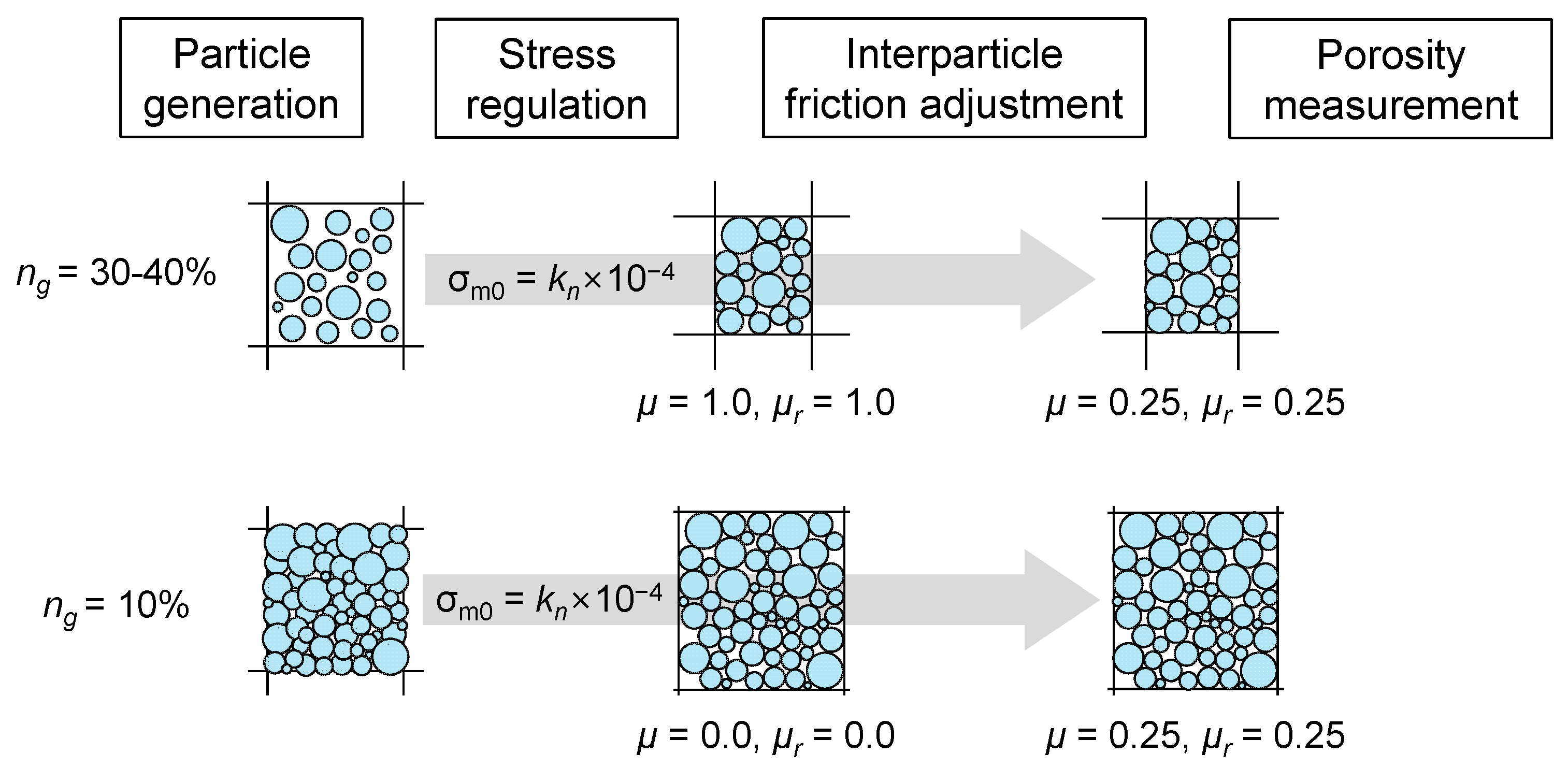
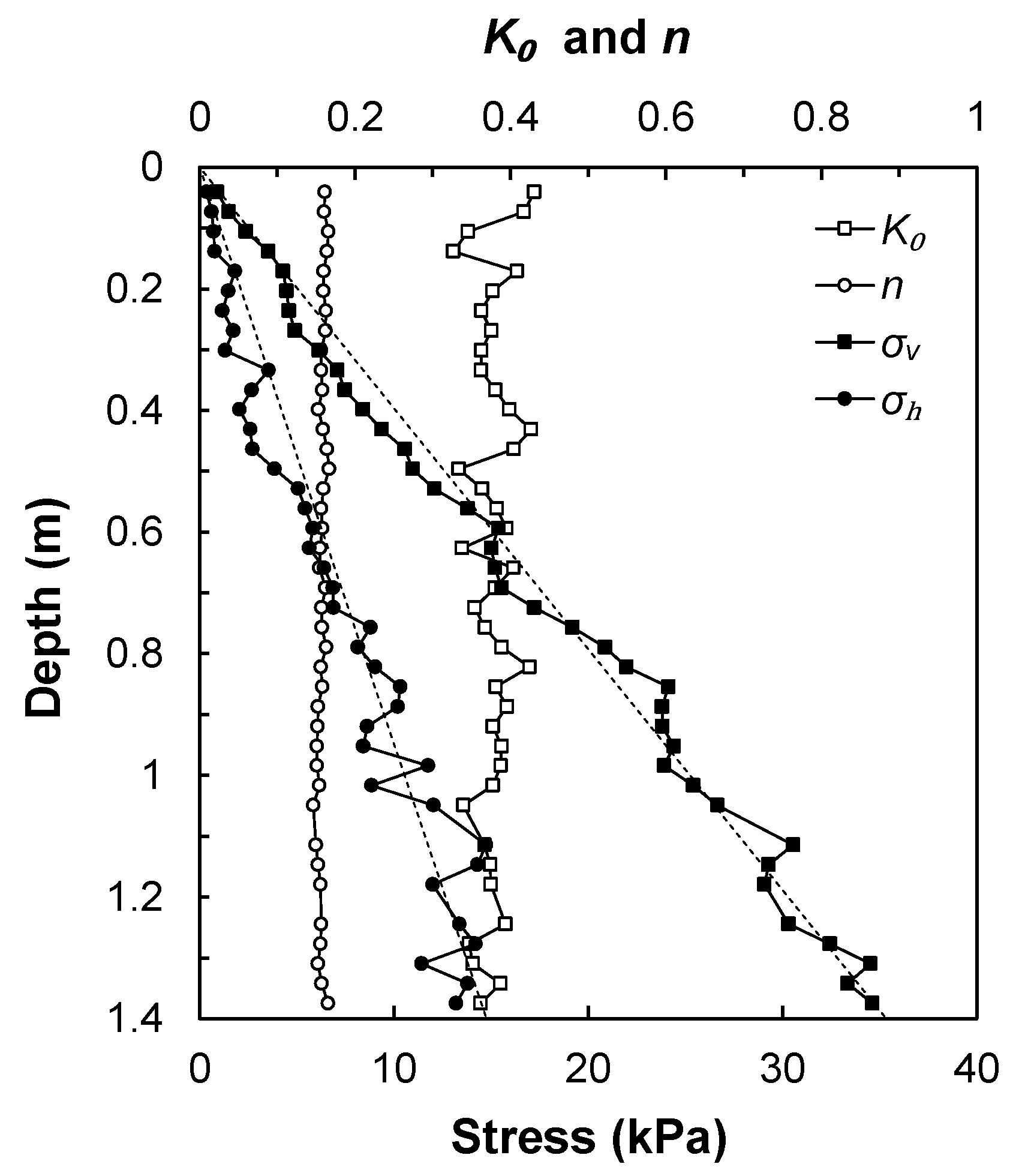
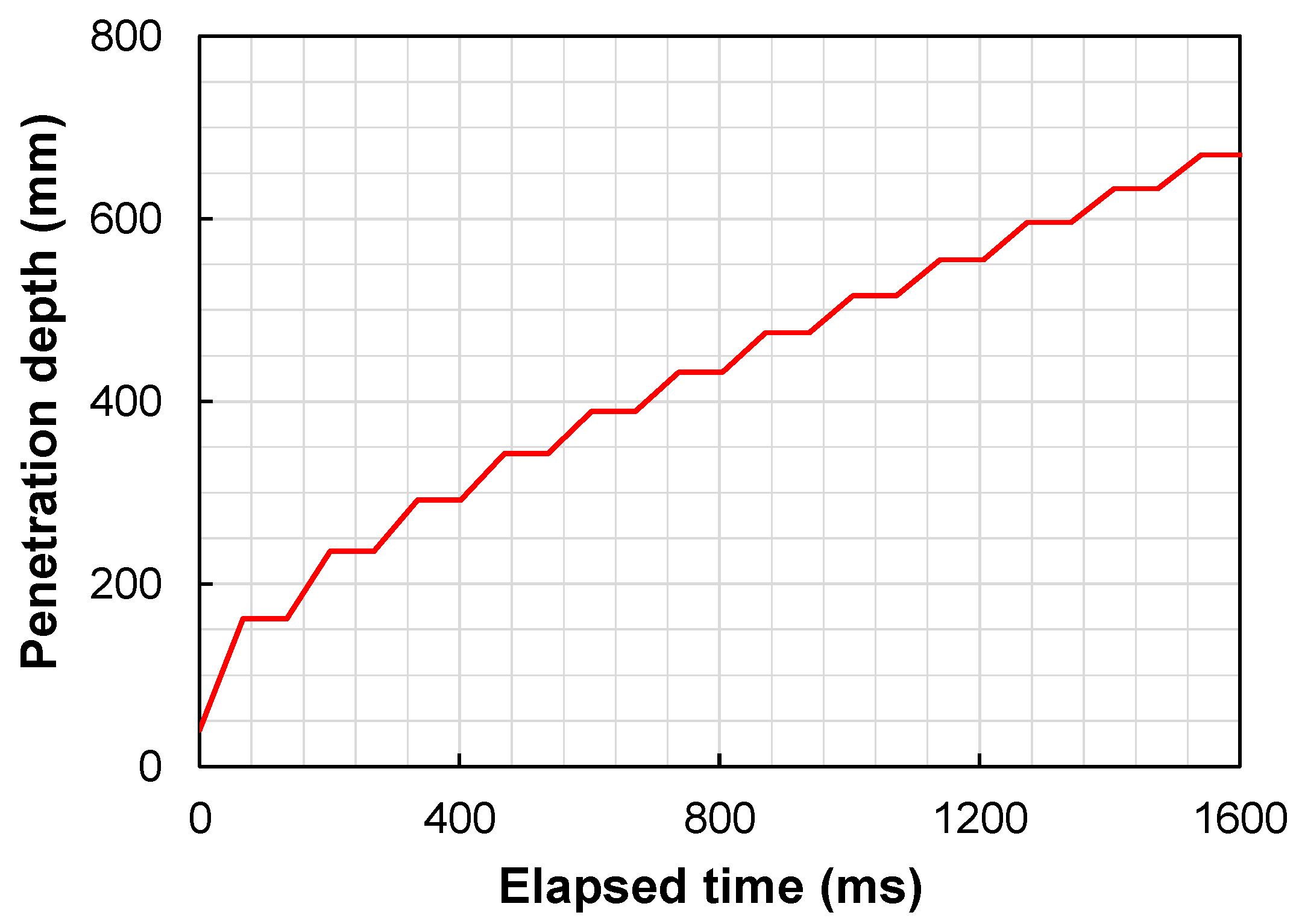

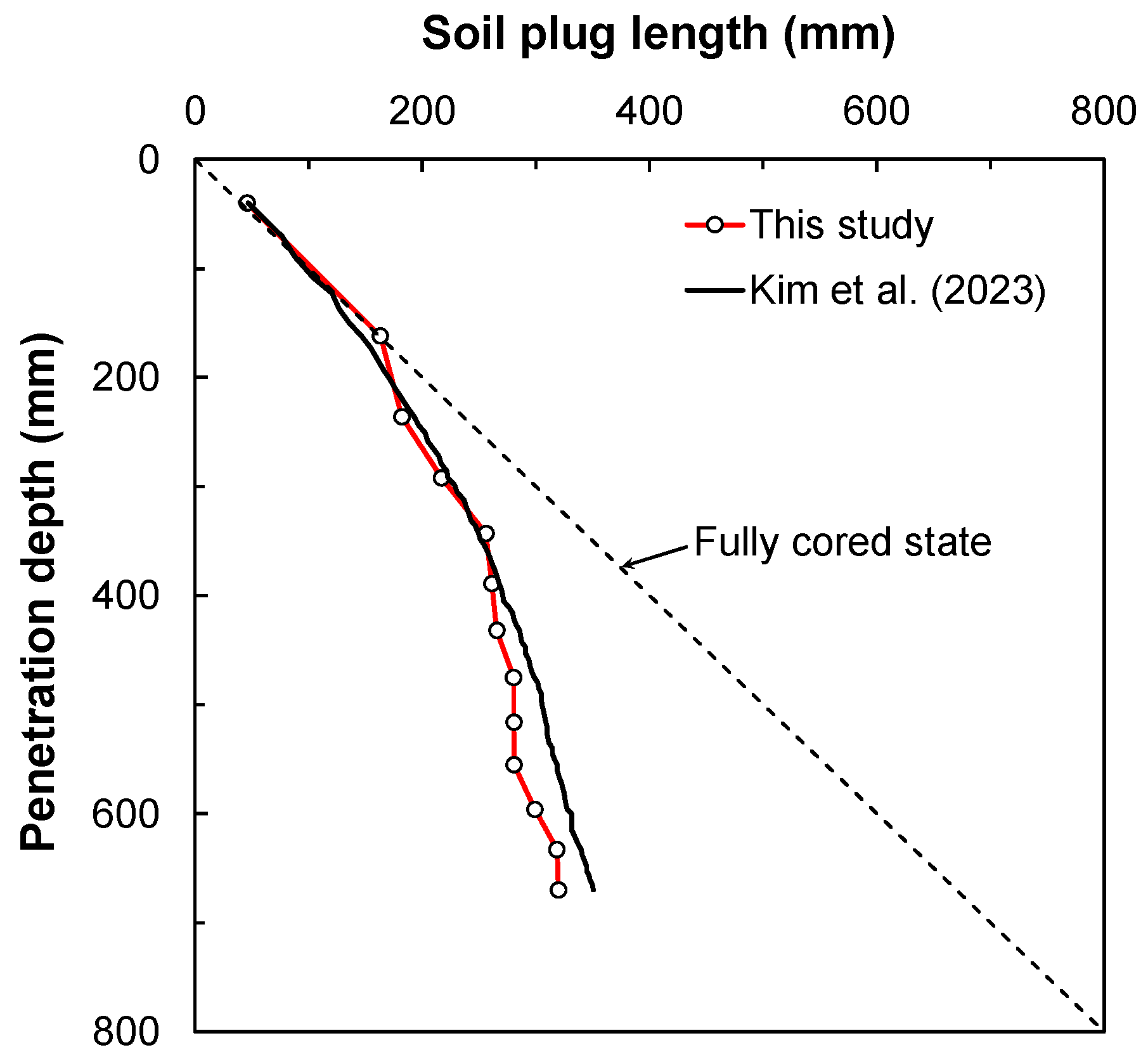
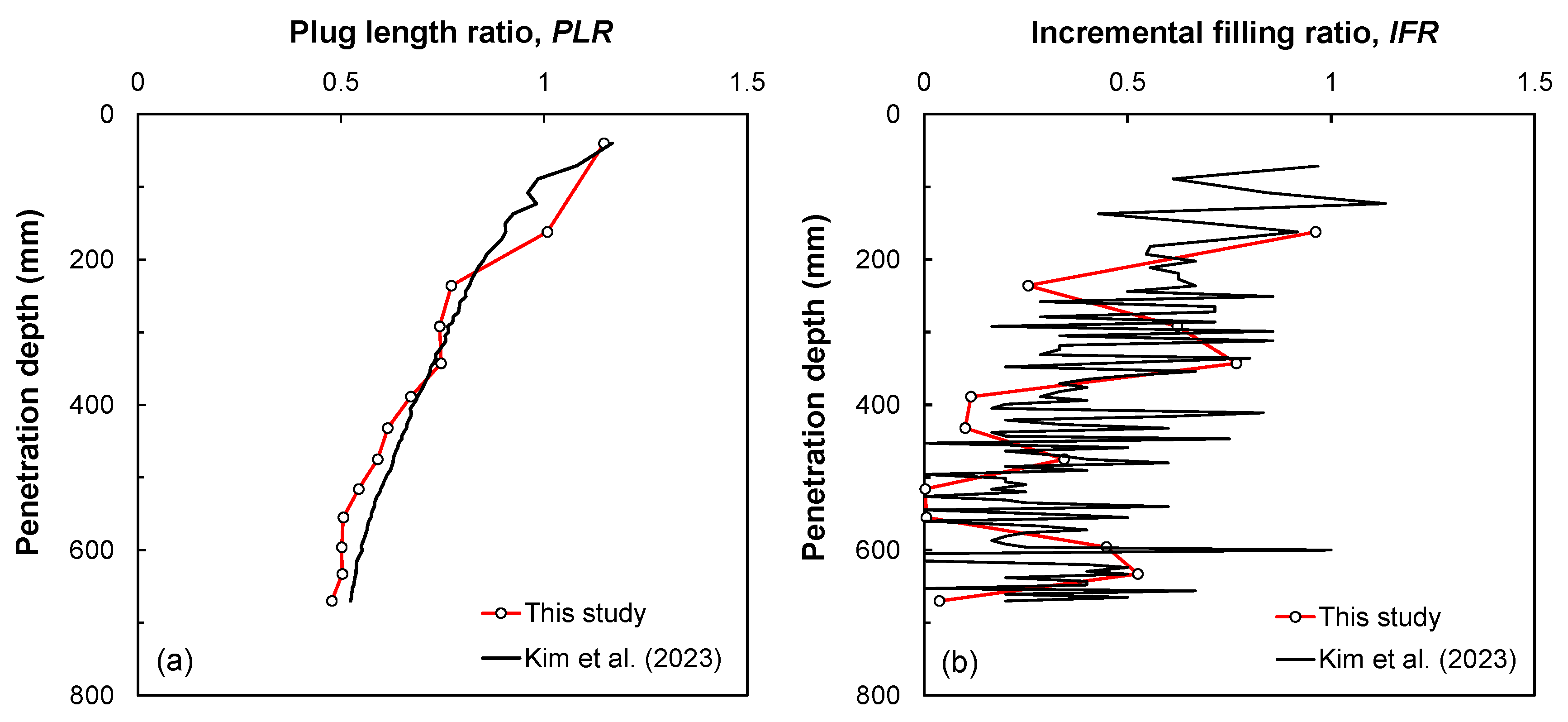
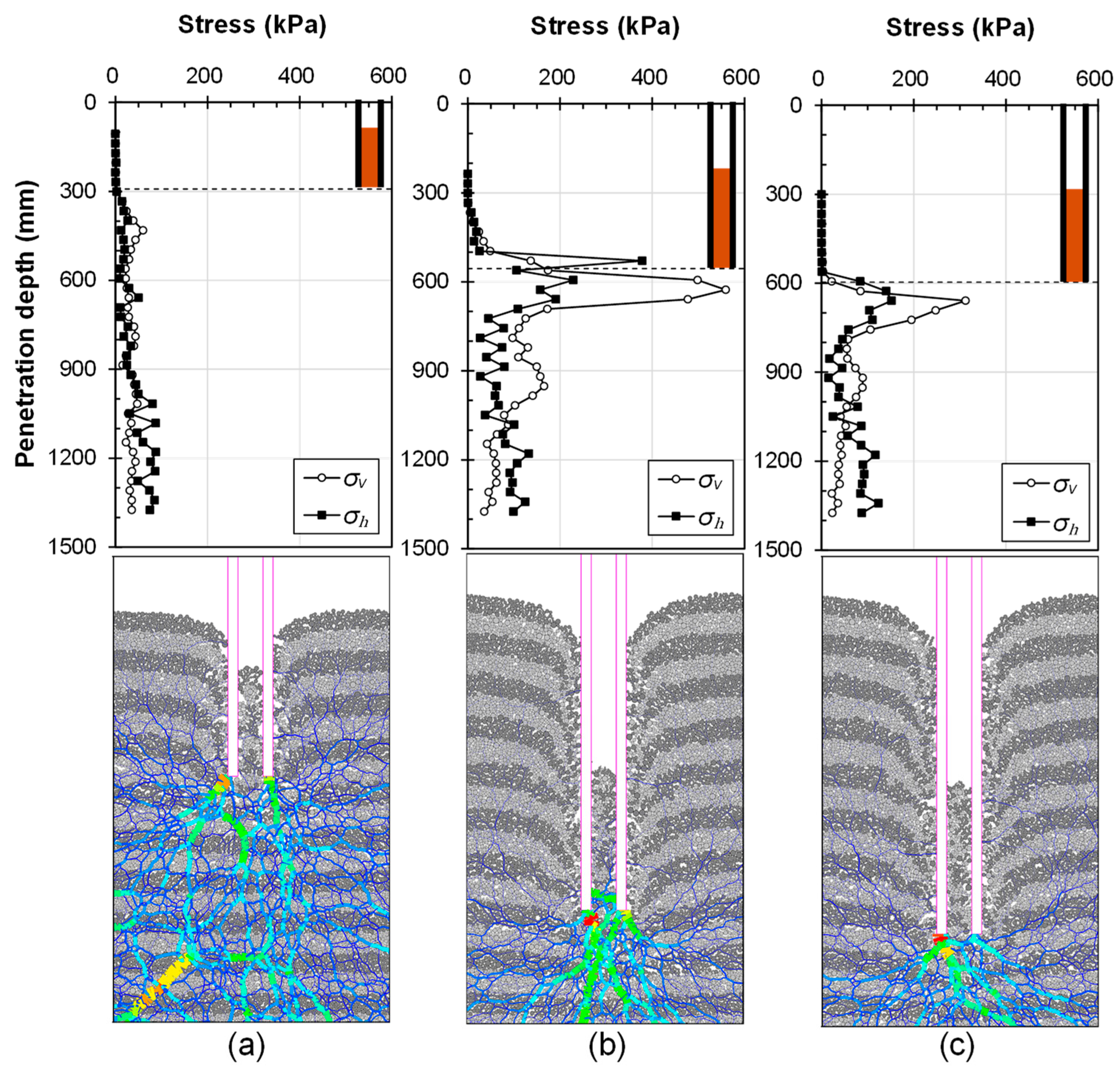
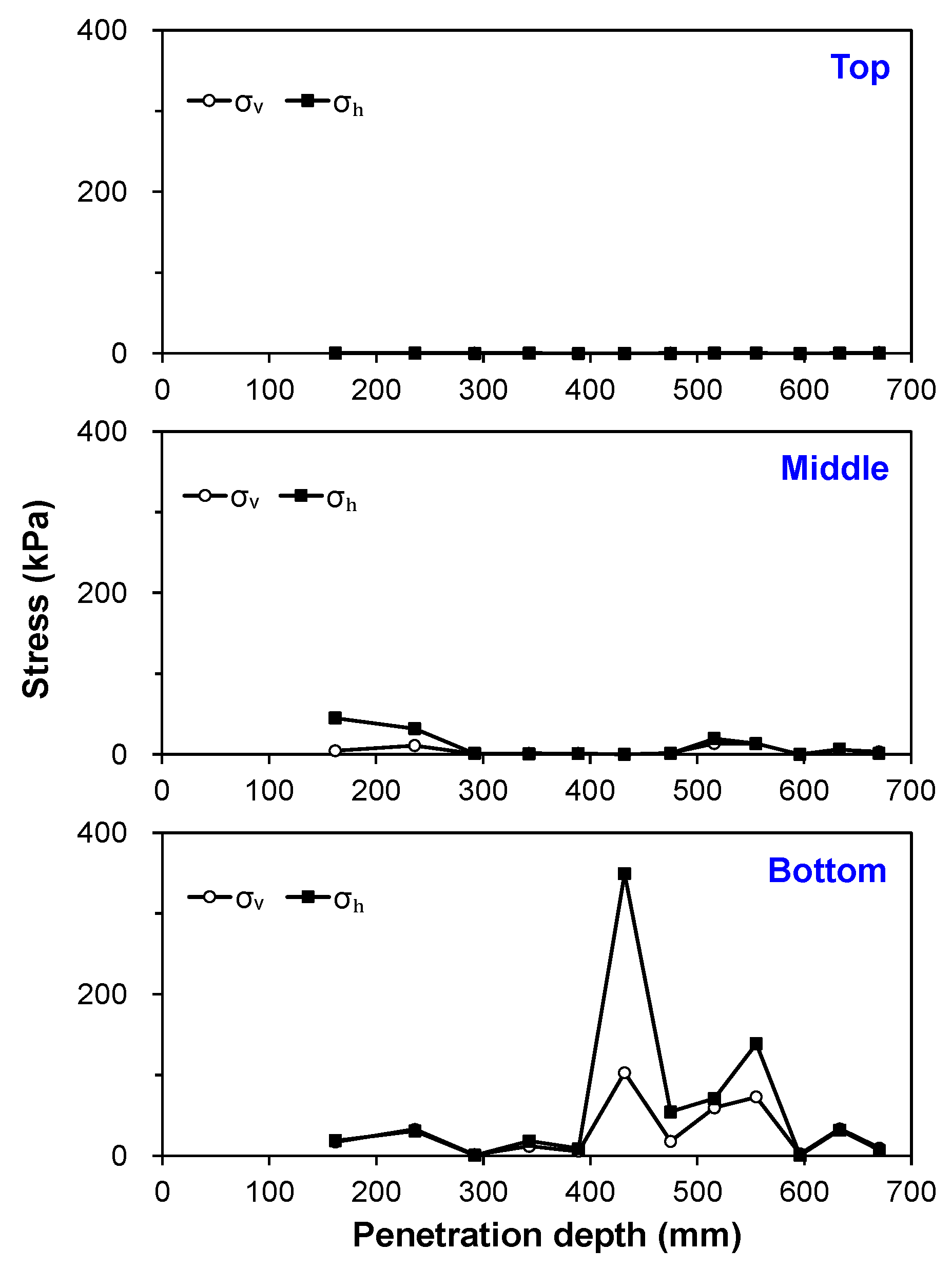
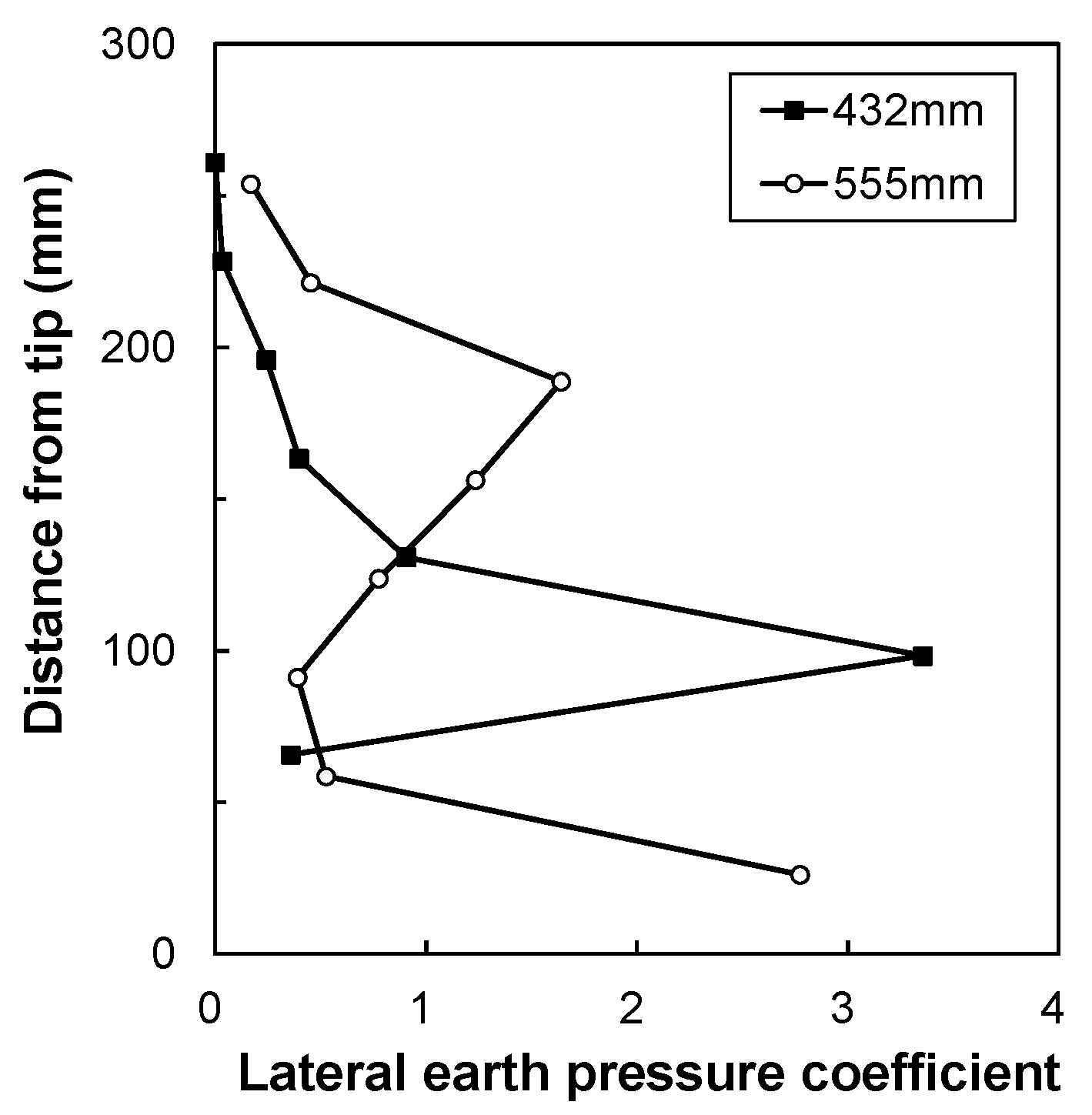
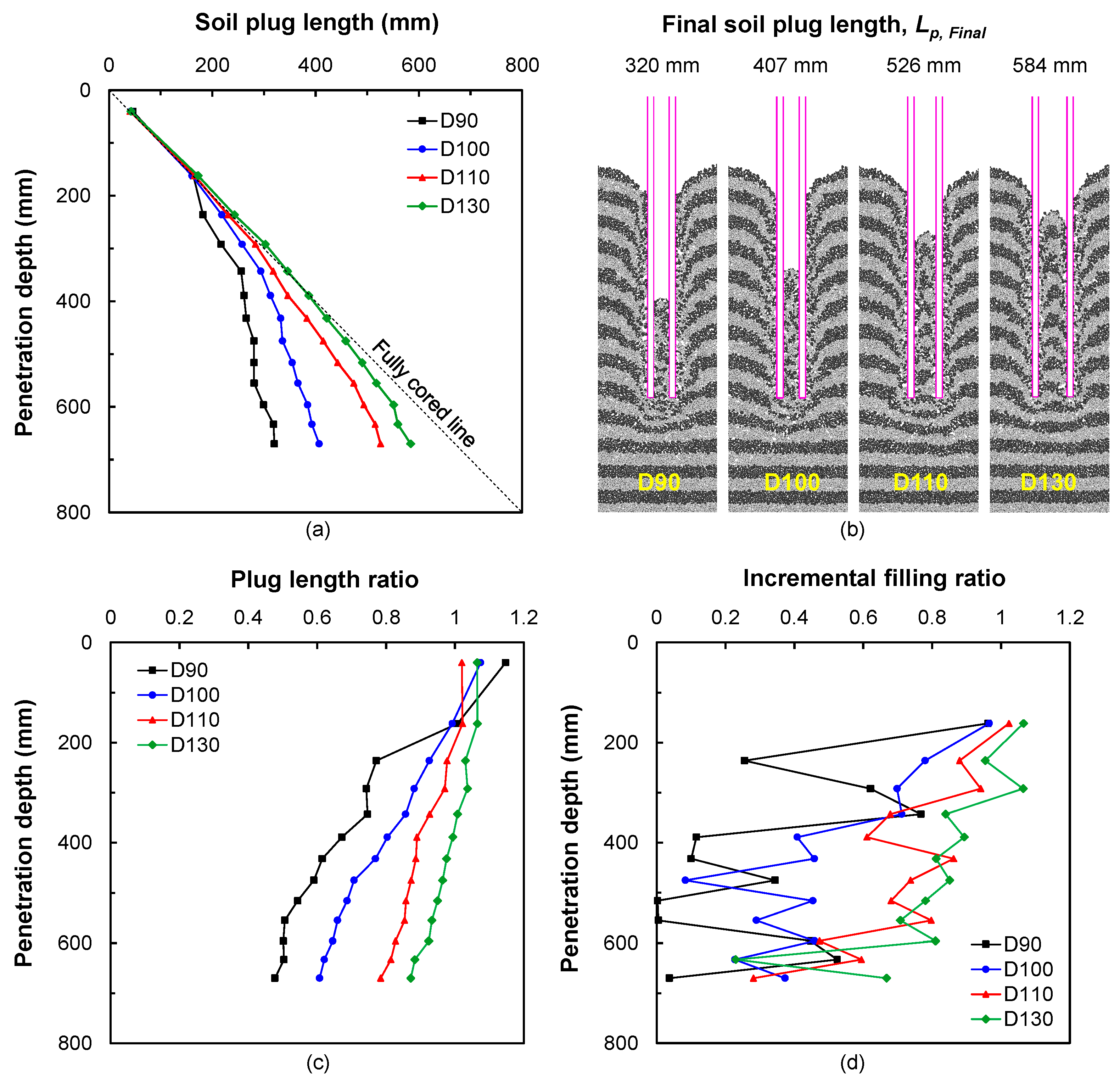

| Soil Properties | Values/Classification |
|---|---|
| D10 (mm) | 0.157 |
| D30 (mm) | 0.211 |
| D50 (mm) | 0.256 |
| D60 (mm) | 0.276 |
| Coefficient of uniformity, Cu | 1.76 |
| Coefficient of curvature, Cc | 1.03 |
| emin and emax [36] | 0.47 and 0.78 |
| Peak friction angle [37] (Dr of 80–90%), (degree) | 38 |
| Critical-state friction angle, (degree) | 32.8 |
| Gs | 2.65 |
| Particle shape | Subangular to subrounded |
| Unified Soil Classification System | Poorly graded sand (SP) |
| Input Parameters | Value |
|---|---|
| Soil properties | |
| Normal stiffness, kn (kN/m) | 1 × 105 |
| Shear stiffness, ks (kN/m) | 2 × 104 |
| Friction coefficient, μ | 0.50 |
| Rolling friction coefficient, μr | 0.45 |
| Specific gravity, Gs | 2.65 |
| Wall properties | |
| Normal stiffness, kn (kN/m) | 1 × 107 |
| Shear stiffness, ks (kN/m) | 1 × 107 |
| Friction coefficient, μ | 0.50 |
Disclaimer/Publisher’s Note: The statements, opinions and data contained in all publications are solely those of the individual author(s) and contributor(s) and not of MDPI and/or the editor(s). MDPI and/or the editor(s) disclaim responsibility for any injury to people or property resulting from any ideas, methods, instructions or products referred to in the content. |
© 2024 by the authors. Licensee MDPI, Basel, Switzerland. This article is an open access article distributed under the terms and conditions of the Creative Commons Attribution (CC BY) license (https://creativecommons.org/licenses/by/4.0/).
Share and Cite
Kim, Y.; Kim, M. Stress State Analysis of the Soil Plug of Open-Ended Piles during Impact Driving Using Particle Flow Code (PFC). Appl. Sci. 2024, 14, 6512. https://doi.org/10.3390/app14156512
Kim Y, Kim M. Stress State Analysis of the Soil Plug of Open-Ended Piles during Impact Driving Using Particle Flow Code (PFC). Applied Sciences. 2024; 14(15):6512. https://doi.org/10.3390/app14156512
Chicago/Turabian StyleKim, Youngsang, and Mintae Kim. 2024. "Stress State Analysis of the Soil Plug of Open-Ended Piles during Impact Driving Using Particle Flow Code (PFC)" Applied Sciences 14, no. 15: 6512. https://doi.org/10.3390/app14156512
APA StyleKim, Y., & Kim, M. (2024). Stress State Analysis of the Soil Plug of Open-Ended Piles during Impact Driving Using Particle Flow Code (PFC). Applied Sciences, 14(15), 6512. https://doi.org/10.3390/app14156512






